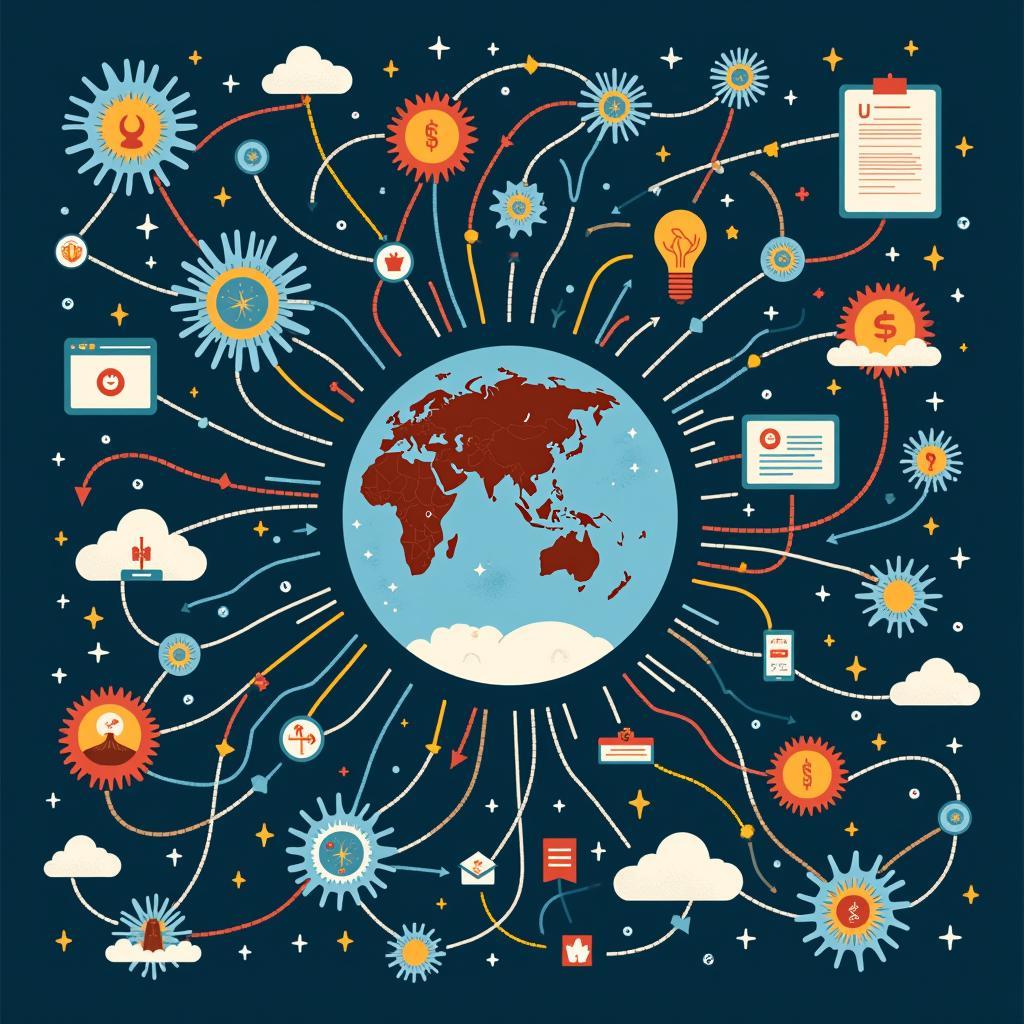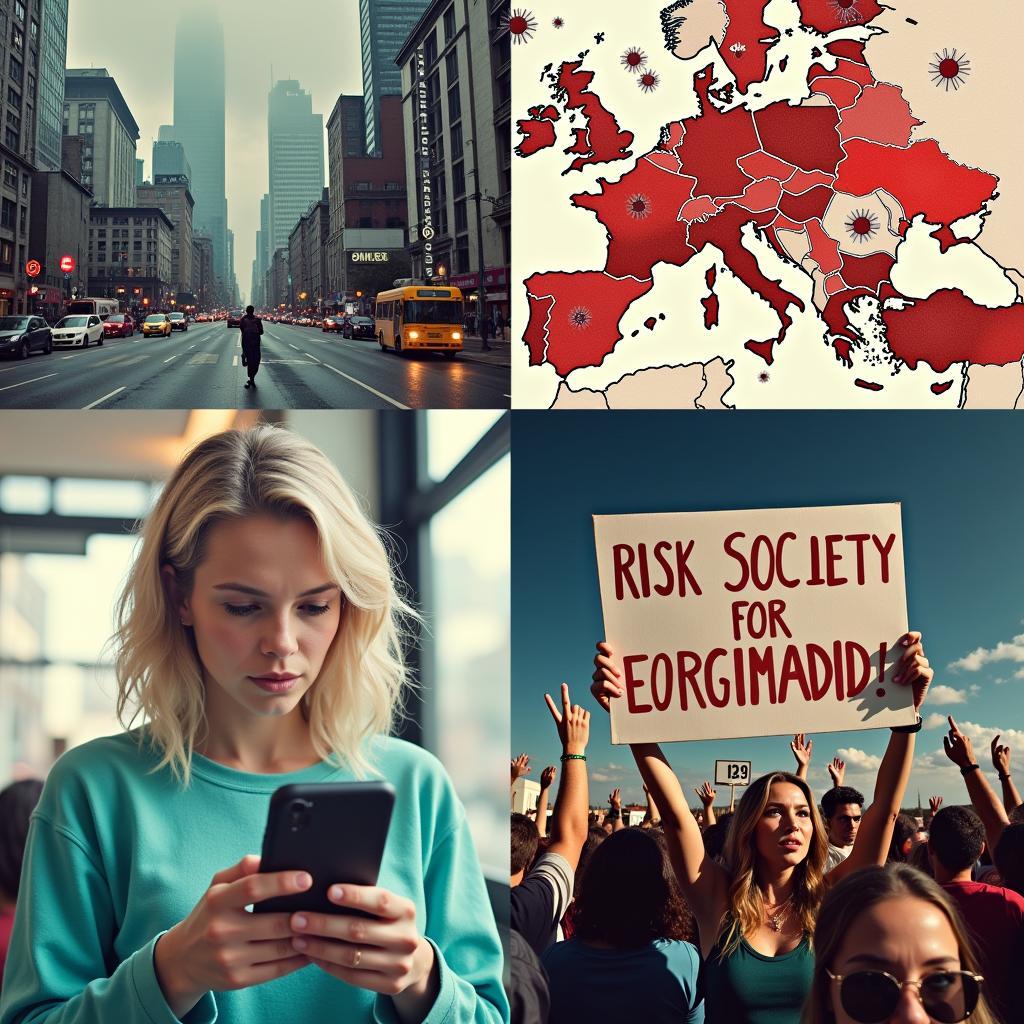In today’s interconnected world, we face a myriad of complex challenges, from climate change and pandemics to economic instability and technological disruption. These challenges are not merely isolated incidents but interconnected facets of what sociologist Ulrich Beck famously termed the “risk society.” This concept, while complex, can be understood through a lens of shared global responsibility and the pursuit of peaceful solutions.
What is the Risk Society?
Ulrich Beck first introduced the concept of the “risk society” in his 1986 book of the same name. He argued that modern societies are increasingly preoccupied with managing risks that are often self-created, invisible, and global in scope. Unlike the localized dangers of earlier eras, these risks transcend geographical boundaries and social divisions, impacting individuals, communities, and nations alike.
 Global Risks Interconnected
Global Risks Interconnected
Key Characteristics of Beck’s Risk Society
Beck identified several key characteristics of the risk society, which distinguish it from earlier periods:
- Manufactured Risks: Unlike natural hazards, many contemporary risks are unintended consequences of human activities, such as industrial pollution, technological failures, or financial speculation.
- Globalization of Risk: Risks know no borders. The Chernobyl disaster, for instance, demonstrated how a localized nuclear accident can have far-reaching global implications.
- Risk Distribution: The benefits and burdens of risk are often unevenly distributed, with marginalized communities and developing countries disproportionately bearing the brunt of environmental degradation or economic exploitation.
- Reflexivity and Uncertainty: The risk society is characterized by a heightened awareness of risk, leading to a constant need for risk assessment and management. However, this reflexivity often creates uncertainty and anxiety as individuals grapple with complex and often invisible threats.
Examples of Risk Society Issues
The risk society framework finds relevance in numerous contemporary issues:
- Climate Change: The global impact of climate change, from rising sea levels to extreme weather events, exemplifies the interconnected nature of manufactured risks in the risk society.
- Global Pandemics: The rapid spread of diseases like COVID-19 highlights the interconnectedness of the modern world and the challenges of managing global health risks.
- Technological Risks: Advances in artificial intelligence, biotechnology, and nanotechnology bring immense potential benefits but also introduce new ethical dilemmas and unforeseen risks.
- Economic Inequality: The widening gap between the rich and the poor creates social tensions and undermines social cohesion, potentially leading to instability and conflict.
 Visualizing Risk Society Examples
Visualizing Risk Society Examples
The Role of Dialogue and Understanding in Mitigating Risk
Navigating the complexities of the risk society demands global cooperation, open dialogue, and a commitment to peaceful solutions. By fostering understanding across cultural and national divides, we can work together to address shared challenges and build a more just and sustainable future.
- Promoting Global Citizenship Education: Educating individuals about global interdependence and fostering empathy for diverse perspectives are crucial for building a more peaceful and collaborative world.
- Strengthening International Institutions: International organizations, such as the United Nations, play a vital role in coordinating responses to global challenges and promoting peaceful cooperation among nations.
- Empowering Civil Society: Grassroots movements and civil society organizations play a critical role in holding power accountable, advocating for social justice, and promoting sustainable practices.
Conclusion
Ulrich Beck’s risk society framework provides a valuable lens through which to understand the interconnected challenges of our time. By recognizing the global nature of risk, embracing dialogue, and working together to find peaceful solutions, we can navigate the uncertainties of the 21st century and build a more just and sustainable future for all. Let’s work together to create a world where peace is not just a dream but a lived reality.
FAQs about the Risk Society
1. What are some criticisms of Beck’s risk society theory?
Some critics argue that Beck’s theory is overly pessimistic and overlooks the potential for human agency and innovation in mitigating risk. Others contend that it doesn’t adequately address the uneven distribution of risk across social classes and nations.
2. How does the risk society concept relate to globalization?
Globalization is a key driver of the risk society, as it intensifies interconnectedness and accelerates the flow of goods, information, and risks across borders.
3. What role can individuals play in addressing the challenges of the risk society?
Individuals can make informed choices, advocate for change, and support organizations working to create a more just and sustainable world.
4. How does the risk society impact our understanding of peace?
In the risk society, peace is not merely the absence of war but a dynamic process of addressing shared challenges and building a more equitable and sustainable future.
5. What are some examples of successful risk mitigation strategies?
International agreements on climate change, global health initiatives, and technological advancements aimed at reducing environmental impact are examples of risk mitigation efforts.
For further insights into building a more peaceful world, explore our other articles on conflict resolution, intercultural dialogue, and sustainable development. If you require assistance, please contact us at Phone Number: 02043854663, Email: [email protected], or visit us at Zone 34, Bac Giang, 260000, Vietnam. We offer 24/7 customer support.